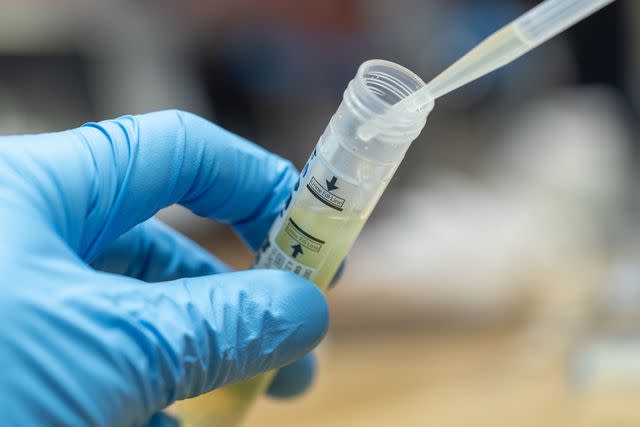Hyaline Casts in Urine: Understanding Ranges on Urinalysis
Medically reviewed by Steffini Stalos, DO
Urine casts result from protein or other materials that conform to the shape of the distal tubules of the kidneys and then get excreted in the urine. They are seen using a microscope's low power field (LPF) during a urine examination (urinalysis) and often indicate kidney disease. Hyaline casts result from a specific protein called "uromodulin."
Sometimes, hyaline casts result from dehydration or strenuous exercise and do not require further testing. Higher than normal hyaline cast levels may prompt additional laboratory and imaging tests to determine if the hyaline casts are due to kidney disease.
This article will help you understand the difference between "normal" and "high" hyaline cast ranges on a urinalysis and what each means for your health.

Rodolfo Parulan Jr. / Getty Images
Read Next: The Anatomy of the Kidneys
Why Are Hyaline Casts in Urine?
Casts are created in the kidney's distal tubules, or collecting ducts, where granular or waxy substances called proteins build up. Often, urine casts can indicate possible kidney disease.
Hyaline casts are composed of specific proteins created by the renal cells, which are known as uromodulin. Because hyaline casts tend to be evident in urine samples collected to examine the cause of slow urinary flow, they can be present without evidence of kidney disease.
Dehydration, diuretic use, or strenuous exercise are possible reasons for hyaline casts when there is no evidence of kidney disease.
Physiological Causes
Hyaline casts are often seen in a urinalysis test as a result of slow or sluggish urinary flow due to:
Intense exercise
Dehydration
Fever (which could cause dehydration)
Diuretic use
Pathological Causes
If the number of hyaline casts seen under a microscope's low power field (LPF) in a urinalysis test is higher than two hyaline casts, a healthcare provider may perform additional testing for the following conditions:
Kidney infection (e.g., pyelonephritis)
Chronic renal disease (e.g., glomerular disease)
Kidney damage from diabetes (i.e., diabetic nephropathy)
Hyaline Cast Results From Urinalysis
The identification of casts in a urinalysis may pose concerning evidence of disease. However, hyaline casts are slightly different because they do not always indicate kidney disease. Generally, zero to two hyaline casts in LPF are not cause for concern.
Uromodulin, the protein created by the renal cells that form hyaline casts, may show up in a urinalysis due to many conditions, such as:
Dehydration
Rigorous exercise
Diuretic use
Kidney infection, like pyelonephritis
Types of Urinary Casts
Urinary casts are divided into two categories, acellular and cellular:
Acellular casts are composed of proteins or fats and include hyaline casts, granular casts, waxy casts, and fatty casts.
Cellular casts are composed of different types of cells, such as red or white blood cells. Cellular casts include red blood cell casts, white blood cell casts, bacterial cell casts, and renal tubule cells.
Normal Range of Hyaline Casts
Hyaline casts are seen under a microscope's LPF. Generally, zero to two hyaline casts/LPF is considered a normal range. A healthcare provider will typically determine whether you need further testing regarding the presence of hyaline casts based on your health history and status.
High Range of Hyaline Casts
Generally, casts are indicative of possible kidney disease. However, hyaline casts are slightly different and can be seen with any possible kidney disease. If more than two hyaline casts/LPF are identified, your healthcare provider should perform more testing to ensure there is no evidence of kidney disease.
Reading | Range | Action |
0–2/LPF | Normal | No follow-up is required |
> 2/LPF | High | Follow-up testing is necessary |
Interpreting Results: What Do High Hyaline Casts Mean?
Hyaline casts can be seen in a microscopic urinalysis test. Generally, a normal amount of hyaline casts is 0–2/LPF. If more than two hyaline casts/LPF are identified in a microscopic urinalysis exam, it could indicate the possibility of kidney disease. Some conditions that could cause high levels of hyaline casts include:
Kidney infection, such as pyelonephritis
Chronic renal disease, such as kidney damage from high blood pressure or lupus
Kidney damage from diabetes, known as diabetic nephropathy
Next Steps With Above Average Hyaline Urine Casts
If more than two hyaline casts/LPF are identified in a microscopic urinalysis exam, a healthcare provider may order further testing to determine if you are at risk for kidney disease. Testing might include:
Laboratory blood testing for current kidney function status
Laboratory urine testing to identify underlying infections, such as urinary tract, bladder, or kidney infection, as evidenced by white blood cells in the urine
Ultrasound or computed tomography (CT) imaging to identify any obstructions or infection in the kidneys, such as from kidney stones, a tumor, or pyelonephritis
Summary
Hyaline casts are a specific type of sediment found in urine. Often, urinary casts can help identify kidney disease processes. Hyaline casts, however, do not always indicate a kidney disease process. It is possible for a urine sample to have a small number of hyaline casts present in the absence of any kidney disease. If the hyaline cast count is greater than two/LPF, it could indicate kidney or heart disease. For such cases, a healthcare provider will likely order additional testing.
Read the original article on Verywell Health.

